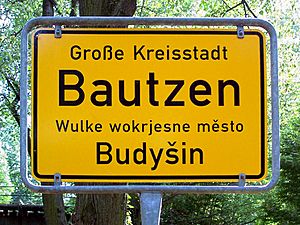Sorbian languages facts for kids
Quick facts for kids Sorbian |
|
|---|---|
| Wendish, Lusatian | |
| Geographic distribution: |
Lusatia |
| Linguistic classification: | Indo-European
|
| Subdivisions: |
Lower Sorbian
|
| ISO 639-2 and 639-5: | wen |
 The Sorbian-speaking region in Germany
|
|
The Sorbian languages are a group of languages that belong to the Slavic family. This family is part of the larger Indo-European languages group.
These languages are spoken by the Sorbs, a Slavic minority group living in eastern Germany. In the past, these languages were also called Wendish or Lusatian.
There are two main Sorbian languages:
- Upper Sorbian (called hornjoserbsce by its speakers) is used by about 40,000 people. Most of these speakers live in the German state of Saxony.
- Lower Sorbian (called dolnoserbski) is spoken by about 10,000 people. Most of them live in the German state of Brandenburg.
The area where both Sorbian languages are spoken is known as Lusatia. This region is called Łužica in Upper Sorbian, Łužyca in Lower Sorbian, and Lausitz in German.
Contents
Sorbian Languages in Germany
In Germany, both Upper and Lower Sorbian are officially recognized. They are protected as minority languages by the European Charter for Regional or Minority Languages. This means the languages have special rights.
In the areas where Sorbs live, both Sorbian languages have the same official status as German. This helps to keep the languages alive and used.
Cultural Centers of Sorbian Languages

The city of Bautzen is very important for Upper Sorbian culture. It is located in Upper Lusatia. You can see signs in both German and Upper Sorbian around the city. For example, the city's name is shown as "Bautzen/Budyšin".
The city of Cottbus (Chóśebuz) is seen as the main cultural center for Lower Sorbian. Like Bautzen, Cottbus also has many signs in both German and Lower Sorbian.
Sorbian Speakers Around the World
Sorbian is also spoken in a small community in Serbin, Lee County, Texas, in the United States. This settlement was founded by Sorbian immigrants. They often called themselves "Wends."
Until recently, newspapers were printed in Sorbian in Serbin. The Sorbian spoken there has changed over time. It has been greatly influenced by the German and English languages spoken nearby.
Many Sorbian communities in America and Australia prefer to use the names "Wends" or "Wendish." They sometimes feel that "Sorb" and "Sorbian" are not good words to use.
Images for kids
-
A bilingual sign in Niesendorf/Niža Wjes near Bautzen
See also
 In Spanish: Lenguas sorabas para niños
In Spanish: Lenguas sorabas para niños


